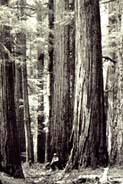
A grove of giant Port Orford cedars, reproduced from a 1911 forestry magazine (13).
|
Chamaecyparis lawsoniana
(A. Murray) Parlatore 1864
Common NamesPort-Orford-cedar, white or Oregon cedar, ginger pine (3); Hort.: Lawson cypress (10, 11).
Taxonomic notesSyn: Cupressus lawsoniana A. Murray 1855 (4).
DescriptionTrees to 50 m tall and 300 cm dbh. Bark reddish brown, stringy, l0-20(25) cm thick on old trees (1-2 cm thick on trees less than c. 100 years old), divided into broad, rounded ridges. Branchlet sprays predominantly pinnate. Leaves of branchlets mostly 2-3 mm, apex acute to acuminate, facial leaves frequently separated by paired bases of lateral leaves; glands usually present, linear. Pollen cones 2-4 mm, red to purple; pollen sacs red. Seed cones maturing and opening in 6-7 months, 8-12 mm broad, glaucous, purplish to reddish brown, not notably resinous; scales (6)8-10, the apical pair fused. Seeds 2-4 per scale, 2-5 mm, wing equal to or broader than body. 2 n = 22 (4, 12).
RangeUSA: From Coos Bay in SW Oregon to the Klamath River in NW California near the coast and locally to 1700 m in the Siskiyou Mountains and Mt. Shasta area. Prefers sandy and clay loams and rocky ridges. Usually in mixed, but sometimes pure stands. Climate cool Mediterreanean with summer fog (1, 4, 5). USDA hardiness zone 7. See also (16).Big TreeDiameter 365 cm, height 69.8 m, crown spread 12 m, located in Siskiyou National Forest, OR (7). The tallest known is 72.8 m, located in the Coquille Falls Research Natural Area, Siskiyou National Forest, Oregon (14). The vast majority of the native range of this species has been logged, and stumps measuring more than 6 metres across are known.OldestAges exceeding 560 years are cited, without supporting data (6).DendrochronologyEthnobotanyThe white, aromatic wood is highly valued by the Japanese for shrines, temples and arrow shafts (1). Originally used for uses as diverse as shipbuilding and match sticks, it is now the most valuable wood harvested in western North America, thanks to past overexploitation. Many cultivars are used as ornamentals (1); it is the most important ornamental conifer species in the U.K., seen mostly as semi-dwarf cultivars in parks and gardens, and planted to the exclusion of many far more interesting species. Welch & Haddow (10) list 559 cultivar names (many of them illegitimate), though a small handful (about 30-40) account for 99% of the trade (12).ObservationsAn old growth stand is preserved in the Coquille River Falls Research Natural Area, Coos County, Oregon, and in general the species reaches its best development in the Coquille River Valley (6).RemarksNamed for Peter Lawson, Scots nurseryman who introduced this species to the horticultural world (1)."A [introduced] pathogenic root rot (Phytophthora lateralis ) has spread through much of the range of Port Orford cedar ( Chamaecyparis lawsoniana ), resulting in the elimination of stands from some habitats and threatening the commercial status of the species throughout its range (Zobel et al. 1985). The root rot has spread from the northern portions of the species range into remote areas, killing trees of all ages. No known genetic resistance or chemical control has been identified. The spores are spread via water or are transported by people, machinery, and animals, and through root grafts (Zobel et al. 1985). Therefore, it is critical for the conservation of this species to close roads and restrict further road construction in watersheds that contain uninfected stands (e.g, inland California populations)" (9). Of all major forest trees found in western North America, this species has suffered most from human activity. Nearly all old-growth forests have been logged, and the surviving trees are steadily dying from an introduced disease. Citations(1) Little 1980.(2) Silba 1986. (3) Peattie 1950. (4) Michener, David C. at the Flora of North America web site. (5) Oregon Trees website. (6) Burns & Honkala 1990. (7) E-mail communication from Robert Van Pelt, who measured these trees; 18-Mar-1998. (9) Forest Ecosystem Management Assessment Team. 1993. Forest ecosystem management: an ecological, economic and social assessment. Washington, DC: U.S. Forest Service and collaborating agencies. Page IV-123. (10) H.J. Welch & G. Haddow 1993. The World Checklist of Conifers. (11) Dallimore et al. 1967. (12) M.P. Frankis, personal observations contributed 3-Feb-1999. (13) Original source pending; graphic received 5-Mar-1999 from Robert Van Pelt. (14) Tree measured by R. Van Pelt and C.J. Earle, 13-May-1999. (15) Personal communication from R. Van Pelt, 13-May-1999, relating an earlier conversation with Frank Callahan. (16) Robert S. Thompson, Katherine H. Anderson and Patrick J. Bartlein. 1999. Atlas of Relations Between Climatic Parameters and Distributions of Important Trees and Shrubs in North America. U.S. Geological Survey Professional Paper 1650 A&B. URL= http://greenwood.cr.usgs.gov/pub/ppapers/p1650-a/pages/conifers.html, accessed 22-Jan-2000.
See also:
This page co-edited with M.P. Frankis, Feb-1999. |
|
[ Chamaecyparis ] [ Cupressaceae ] [ home ]
This page is from the Gymnosperm Database
|